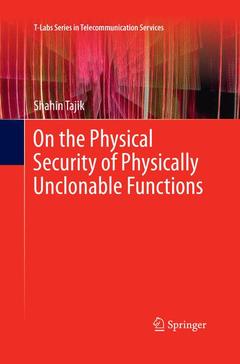Description
On the Physical Security of Physically Unclonable Functions, Softcover reprint of the original 1st ed. 2019
T-Labs Series in Telecommunication Services Series
Author: Tajik Shahin
Language: English
Subjects for On the Physical Security of Physically Unclonable Functions:
On the Physical Security of Physically Unclonable Functions
Publication date: 02-2019
Support: Print on demand
Publication date: 02-2019
Support: Print on demand
On the Physical Security of Physically Unclonable Functions
Publication date: 04-2018
Support: Print on demand
Publication date: 04-2018
Support: Print on demand
Description
/li>Contents
/li>Comment
/li>
This book investigates the susceptibility of intrinsic physically unclonable function (PUF) implementations on reconfigurable hardware to optical semi-invasive attacks from the chip backside. It explores different classes of optical attacks, particularly photonic emission analysis, laser fault injection, and optical contactless probing. By applying these techniques, the book demonstrates that the secrets generated by a PUF can be predicted, manipulated or directly probed without affecting the behavior of the PUF. It subsequently discusses the cost and feasibility of launching such attacks against the very latest hardware technologies in a real scenario. The author discusses why PUFs are not tamper-evident in their current configuration, and therefore, PUFs alone cannot raise the security level of key storage. The author then reviews the potential and already implemented countermeasures, which can remedy PUFs? security-related shortcomings and make them resistant to optical side-channeland optical fault attacks. Lastly, by making selected modifications to the functionality of an existing PUF architecture, the book presents a prototype tamper-evident sensor for detecting optical contactless probing attempts.
Introduction.- Background.- Experimental Setup.- Photonic Side-Channel Analysis.- Laser Fault Injection.- Optical Contactless Probing.- Conclusion.
Investigates the susceptibility of intrinsic physically unclonable function (PUF) implementations to attacks from the chip backside Demonstrates that the secrets generated by a PUF can be predicted, manipulated, or directly probed Explores the cost and feasibility of launching attacks against the very latest hardware technologies Presents a prototype tamper-evident sensor for detecting optical contactless probing attempts
© 2024 LAVOISIER S.A.S.




